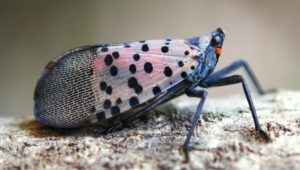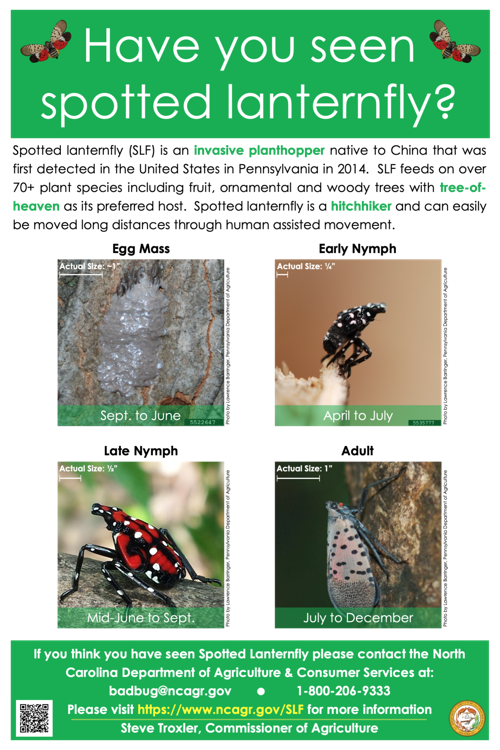Spotted Lanternfly: Early Detection Key for NC
go.ncsu.edu/readext?753963
en Español / em Português
El inglés es el idioma de control de esta página. En la medida en que haya algún conflicto entre la traducción al inglés y la traducción, el inglés prevalece.
Al hacer clic en el enlace de traducción se activa un servicio de traducción gratuito para convertir la página al español. Al igual que con cualquier traducción por Internet, la conversión no es sensible al contexto y puede que no traduzca el texto en su significado original. NC State Extension no garantiza la exactitud del texto traducido. Por favor, tenga en cuenta que algunas aplicaciones y/o servicios pueden no funcionar como se espera cuando se traducen.
Português
Inglês é o idioma de controle desta página. Na medida que haja algum conflito entre o texto original em Inglês e a tradução, o Inglês prevalece.
Ao clicar no link de tradução, um serviço gratuito de tradução será ativado para converter a página para o Português. Como em qualquer tradução pela internet, a conversão não é sensivel ao contexto e pode não ocorrer a tradução para o significado orginal. O serviço de Extensão da Carolina do Norte (NC State Extension) não garante a exatidão do texto traduzido. Por favor, observe que algumas funções ou serviços podem não funcionar como esperado após a tradução.
English
English is the controlling language of this page. To the extent there is any conflict between the English text and the translation, English controls.
Clicking on the translation link activates a free translation service to convert the page to Spanish. As with any Internet translation, the conversion is not context-sensitive and may not translate the text to its original meaning. NC State Extension does not guarantee the accuracy of the translated text. Please note that some applications and/or services may not function as expected when translated.
Collapse ▲
Photo credit: Lawrence Barringer, Pennsylvania Department of Agriculture, Bugwood
Spotted Lanternfly, an invasive planthopper has recently been found in Ohio. Inspectors from the Department of Agriculture found 5 live adults among trees along the Ohio River in October 2020. Ohio now becomes the 11th eastern state where the spotted lanternfly has been detected. This pest poses a threat to tree fruit and grapes, which is why early detection is critical in stopping its spread and minimizing the devastating effect it could have on our agriculture industry here in North Carolina. To help us with early detection learn more about this pest through our resource link below and read the steps you should take if you suspect you have seen a spotted lanternfly in North Carolina.
Learn More About Spotted Lanternfly Through Our NC State Extension Resource Page
If you think you have seen spotted lanternfly in North Carolina:
- Please take a photo and send it to badbug@ncagr.gov.
- When submitting a photo please include the location of the sighting, the date, and your contact information.
- Clear, close-up, focused images are the easiest to ID! If possible, add a coin, paper clip, or other small objects to the photo to indicate the size of the insect.





